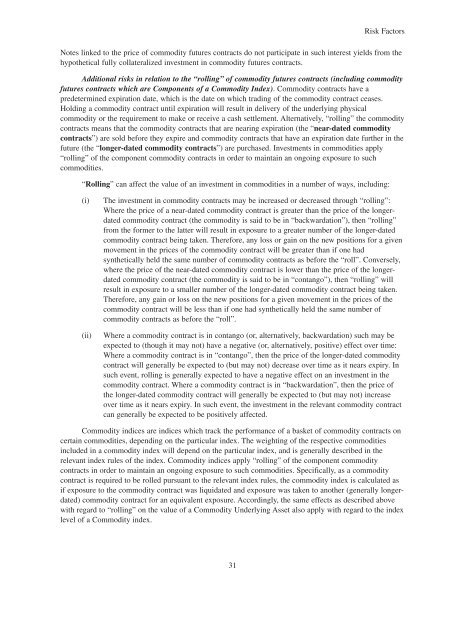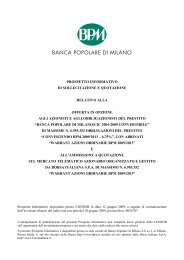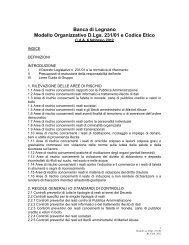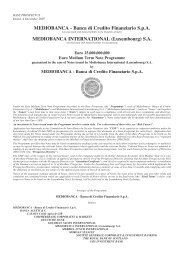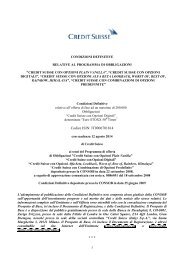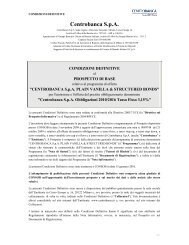INDEX OF DEFINED TERMS - Banca di Legnano
INDEX OF DEFINED TERMS - Banca di Legnano
INDEX OF DEFINED TERMS - Banca di Legnano
You also want an ePaper? Increase the reach of your titles
YUMPU automatically turns print PDFs into web optimized ePapers that Google loves.
Level: 2 – From: 2 – Wednesday, July 21, 2010 – 11:55 – eprint6 – 4247 Section 02<br />
Risk Factors<br />
Notes linked to the price of commo<strong>di</strong>ty futures contracts do not participate in such interest yields from the<br />
hypothetical fully collateralized investment in commo<strong>di</strong>ty futures contracts.<br />
Ad<strong>di</strong>tional risks in relation to the “rolling” of commo<strong>di</strong>ty futures contracts (inclu<strong>di</strong>ng commo<strong>di</strong>ty<br />
futures contracts which are Components of a Commo<strong>di</strong>ty Index). Commo<strong>di</strong>ty contracts have a<br />
predetermined expiration date, which is the date on which tra<strong>di</strong>ng of the commo<strong>di</strong>ty contract ceases.<br />
Hol<strong>di</strong>ng a commo<strong>di</strong>ty contract until expiration will result in delivery of the underlying physical<br />
commo<strong>di</strong>ty or the requirement to make or receive a cash settlement. Alternatively, “rolling” the commo<strong>di</strong>ty<br />
contracts means that the commo<strong>di</strong>ty contracts that are nearing expiration (the “near-dated commo<strong>di</strong>ty<br />
contracts”) are sold before they expire and commo<strong>di</strong>ty contracts that have an expiration date further in the<br />
future (the “longer-dated commo<strong>di</strong>ty contracts”) are purchased. Investments in commo<strong>di</strong>ties apply<br />
“rolling” of the component commo<strong>di</strong>ty contracts in order to maintain an ongoing exposure to such<br />
commo<strong>di</strong>ties.<br />
“Rolling” can affect the value of an investment in commo<strong>di</strong>ties in a number of ways, inclu<strong>di</strong>ng:<br />
(i)<br />
(ii)<br />
The investment in commo<strong>di</strong>ty contracts may be increased or decreased through “rolling”:<br />
Where the price of a near-dated commo<strong>di</strong>ty contract is greater than the price of the longerdated<br />
commo<strong>di</strong>ty contract (the commo<strong>di</strong>ty is said to be in “backwardation”), then “rolling”<br />
from the former to the latter will result in exposure to a greater number of the longer-dated<br />
commo<strong>di</strong>ty contract being taken. Therefore, any loss or gain on the new positions for a given<br />
movement in the prices of the commo<strong>di</strong>ty contract will be greater than if one had<br />
synthetically held the same number of commo<strong>di</strong>ty contracts as before the “roll”. Conversely,<br />
where the price of the near-dated commo<strong>di</strong>ty contract is lower than the price of the longerdated<br />
commo<strong>di</strong>ty contract (the commo<strong>di</strong>ty is said to be in “contango”), then “rolling” will<br />
result in exposure to a smaller number of the longer-dated commo<strong>di</strong>ty contract being taken.<br />
Therefore, any gain or loss on the new positions for a given movement in the prices of the<br />
commo<strong>di</strong>ty contract will be less than if one had synthetically held the same number of<br />
commo<strong>di</strong>ty contracts as before the “roll”.<br />
Where a commo<strong>di</strong>ty contract is in contango (or, alternatively, backwardation) such may be<br />
expected to (though it may not) have a negative (or, alternatively, positive) effect over time:<br />
Where a commo<strong>di</strong>ty contract is in “contango”, then the price of the longer-dated commo<strong>di</strong>ty<br />
contract will generally be expected to (but may not) decrease over time as it nears expiry. In<br />
such event, rolling is generally expected to have a negative effect on an investment in the<br />
commo<strong>di</strong>ty contract. Where a commo<strong>di</strong>ty contract is in “backwardation”, then the price of<br />
the longer-dated commo<strong>di</strong>ty contract will generally be expected to (but may not) increase<br />
over time as it nears expiry. In such event, the investment in the relevant commo<strong>di</strong>ty contract<br />
can generally be expected to be positively affected.<br />
Commo<strong>di</strong>ty in<strong>di</strong>ces are in<strong>di</strong>ces which track the performance of a basket of commo<strong>di</strong>ty contracts on<br />
certain commo<strong>di</strong>ties, depen<strong>di</strong>ng on the particular index. The weighting of the respective commo<strong>di</strong>ties<br />
included in a commo<strong>di</strong>ty index will depend on the particular index, and is generally described in the<br />
relevant index rules of the index. Commo<strong>di</strong>ty in<strong>di</strong>ces apply “rolling” of the component commo<strong>di</strong>ty<br />
contracts in order to maintain an ongoing exposure to such commo<strong>di</strong>ties. Specifically, as a commo<strong>di</strong>ty<br />
contract is required to be rolled pursuant to the relevant index rules, the commo<strong>di</strong>ty index is calculated as<br />
if exposure to the commo<strong>di</strong>ty contract was liquidated and exposure was taken to another (generally longerdated)<br />
commo<strong>di</strong>ty contract for an equivalent exposure. Accor<strong>di</strong>ngly, the same effects as described above<br />
with regard to “rolling” on the value of a Commo<strong>di</strong>ty Underlying Asset also apply with regard to the index<br />
level of a Commo<strong>di</strong>ty index.<br />
31


